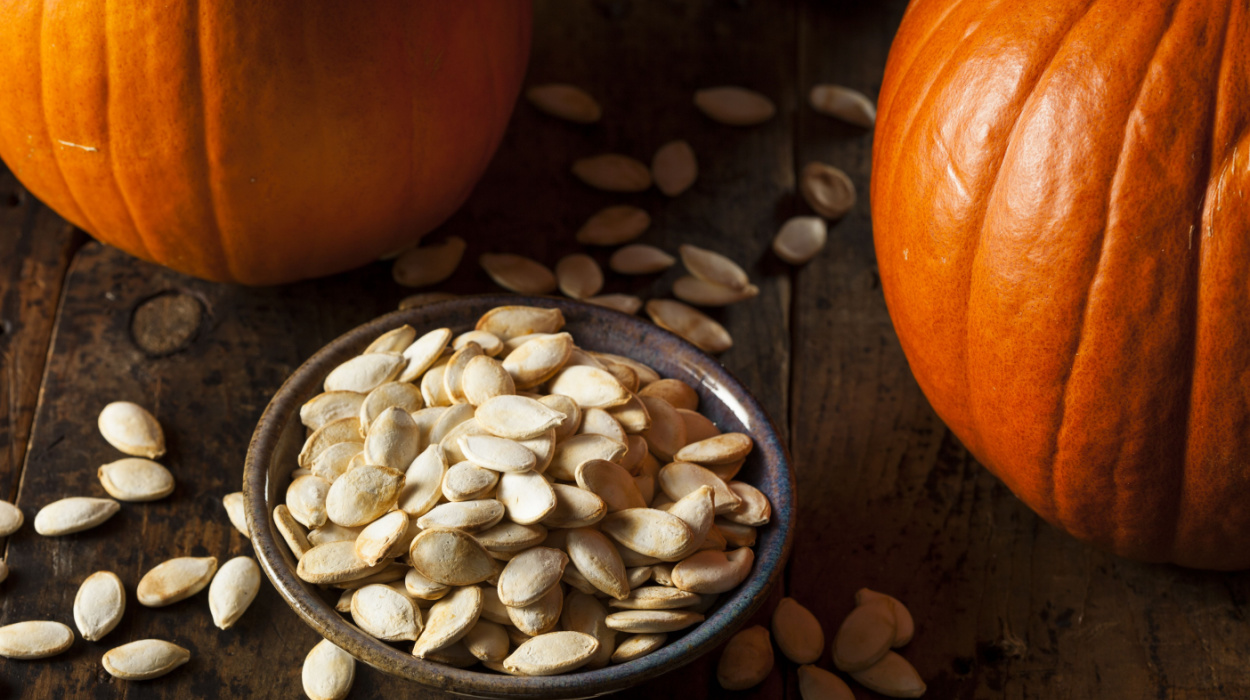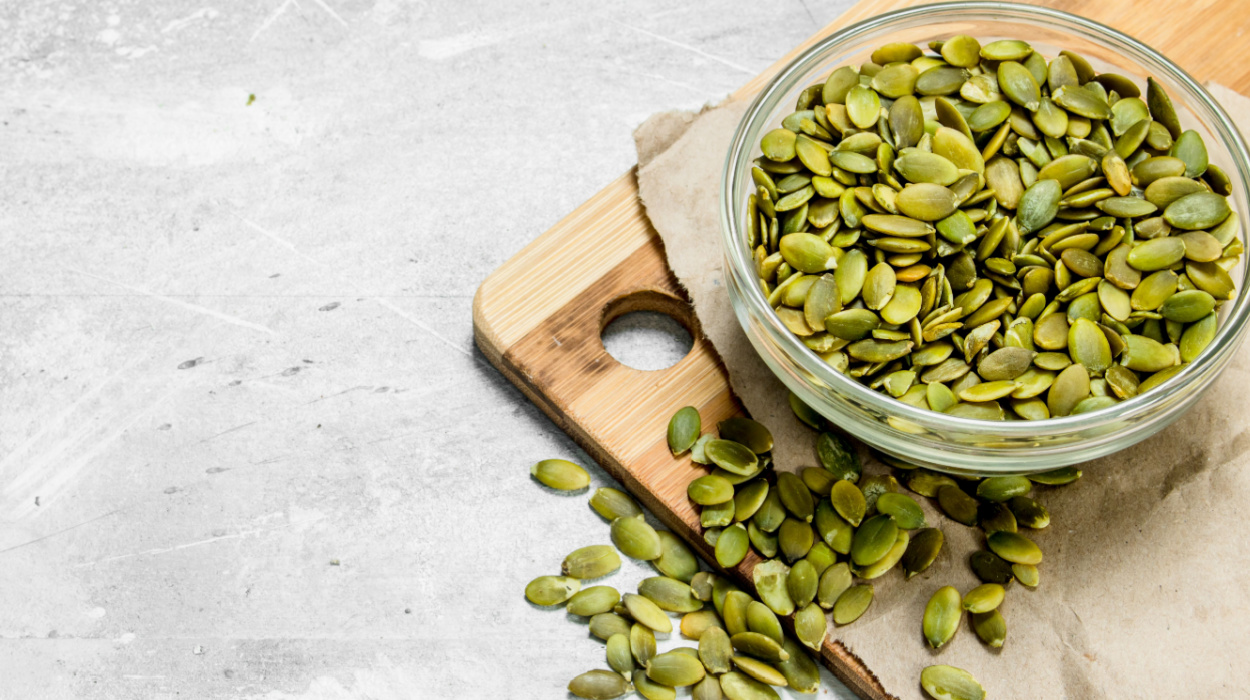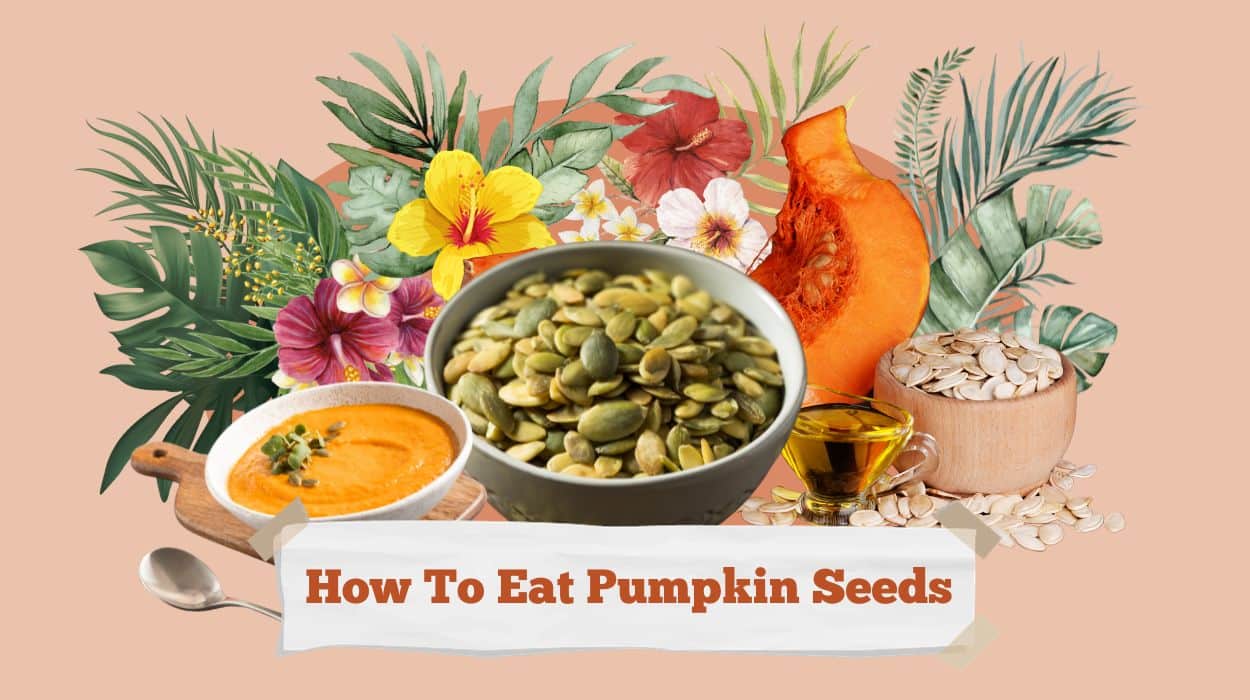Pumpkin seeds, also called pepitas, are the seeds from pumpkins and squash, which are filled with health-enhancing nutrients. They are loaded with zinc, copper, iron, magnesium, and other minerals, as well as contain a good amount of healthy fats, fiber, and protein. This makes pumpkin seeds a healthy late-night snack if you ever find yourself peckish before bed. Preparing pumpkin seeds is enough to include in almost any meal, such as salads, oatmeal, and even smoothies. As small as they are, pumpkin seeds pack a mighty punch of nutrition, improving heart health and lowering the overall risk of disease. Because of this, you may want to consider adding pumpkin seeds to your diet plan along with some of the best fruit and vegetable supplements.
How To Eat Pumpkin Seeds?
There’s nothing easier or more enjoyable than eating pumpkin seeds – they go with everything! Consider these fun ways to get more pumpkin seeds into your daily meals:
- Pumpkin seed salad
- Pumpkin seed soup
- Pumpkin seed smoothie
- Pumpkin seed oatmeal or cereal
- Pumpkin seed cookies
- Pumpkin seed granola bar
- Pumpkin seed bread
- Roasted pumpkin seeds
How To Eat Pumpkin Seeds?
Pumpkin Seed Salad
The beautiful thing about salad is that you can mix match and combine as many different ingredients as you like! You may want to build a salad around shelled pumpkin seeds, in which the seeds are the main “base”, adding in things like fruit, other seeds, nuts, olive oil, shredded cheese or carrots, tomatoes, etc. Adding raisins and cinnamon can create more of a trail mix than a salad, but still a healthy choice, nonetheless.
Otherwise, pumpkin seeds make an excellent salad topper to a traditional salad with lettuce and other veggies. Simply add a handful of seeds to the salad and toss with a healthy salad dressing, then enjoy!
Pumpkin Seed Soup
To make a soup with pumpkin seeds, you’ll need a food processor, heavy-duty blender, or a coffee grinder. This will allow you to chop, blend, and/or grind the seeds so that they can be mixed into the soup. Blend, process, or grind the seeds, then stir into a veggie or bone broth of your choice. Add in whatever seasoning and vegetables you desire! Additionally, you may want to add whole pumpkin seeds on top of the soup, for a crunchy cracker alternative.
Pumpkin Seed Smoothie
Next time you’re making a smoothie, consider adding pumpkin seeds to it. It’s as simple as throwing in a quarter cup of pumpkin seeds with your favorite fruit, veggies, and milk of choice. You may prefer to use a coffee/seed grinder to grind the seeds into a powder first to make sure they blend into the smoothie well. Adding the seeds to smoothies helps bulk up the smoothie with more fiber, fat, protein, and nutrients than a fruit smoothie alone.
Pumpkin Seed Oatmeal Or Cereal
Optimize your breakfast by adding pumpkin seeds to your oatmeal or cereal. Cereal or oats alone provide carbohydrates, but not much else in the way of nutrition. This can be problematic for blood sugar, especially during the first meal of the day. The way to keep your blood sugar stable and feel satiated for longer is to include fiber, protein, and fat along with your carbs. The fiber[1] also helps to increase beneficial bacteria in the gut, which is essential for immunity, among other health benefits. Besides, adding pumpkin seeds to your cereal or oatmeal also gives your breakfast more flavor and variety!
Pumpkin Seed Cookies
Whatever your favorite cookie – chocolate chip, peanut butter crunch, gingersnap – upgrade your cookie recipe by adding pumpkin seeds to the batter. The seeds make a great addition to cookies because the fat[2] and fiber in the seeds help to offset the sugar spike cookies can cause. Pumpkin seeds are also light in taste, which means they blend in well with other flavors. If you prefer not to feel the crunch of seeds in your cookies, you can grind the seeds into a powder and sprinkle them into the batter (all the health benefits without the hard feel).
Pumpkin Seed Granola Bar
The whole point of granola bars is to have an easy snack you can take with you on the go. The problem with a lot of granola bars, though, is that they’re filled with brown sugar and don’t offer much in the way of health or long-term satiety. To make a healthier granola bar that will satisfy your hunger, consider adding pumpkin seeds. Simply take rolled oats, nuts, honey, a pinch of sea salt, and maybe some nut butter as well, and mix them. Bake them in the oven for a few minutes, then once they’re cool, you can mold them into bar shapes (or roll them into granola balls).
Pumpkin Seed Bread
There’s nothing like homemade bread – unless that homemade bread has pumpkin seeds in it! As with making cookies, you may choose to add the pumpkin seeds whole or grind them into a powder first and mix them into the batter/dough. For bread, you’ll need flour (wheat, almond, quinoa, rice, buckwheat or oat, etc.), salt, water and yeast. You may also choose to use eggs if well tolerated. Prepare pumpkin seeds in the bread dough as you would make bread, then mix it in. You may also choose to add the seeds only to the top/outside of the dough so that they embed along the outside crust.
Roasted Pumpkin Seeds

Sometimes the best way to eat pumpkin seed shells is not by adding or mixing them into anything, but rather, on their own by the handful. They are particularly tasty after being roasted. Simply lay the raw pumpkin seeds on a baking tray and put them in the oven for just a few minutes. Alternatively, you may wish to put them in a frying pan and let them roast that way. You can roast pumpkin seeds with a little sea salt or other spices, or go a sweet route and roast them with honey and cinnamon.
Pumpkin Seed Butter
Essentially, any nut or seed (whether sesame, sunflower, almond, or cashew) can be pressed into a butter consistency. Use a food processor or nut pressor to create your own healthy, delicious, creamy pumpkin seed butter. Consume pumpkin seeds and various nuts and seeds,[3] including in butter form like melted butter, can reduce disease risk, however, peanuts are a controversial nut/bean that can be problematic for some individuals (they are higher in mold and pose more allergy risk than other nuts or legumes). Therefore, it’s worthwhile to explore other nut and seed butter aside from peanut butter – like pumpkin seed butter!
Pumpkin Seeds Nutritional Profile
Pumpkin seeds contain many essential vitamins and nutrients,[4] including magnesium, manganese, vitamin K, zinc, iron, copper, phosphorus, and potassium. One serving of pumpkin seeds, which equals about a quarter of a cup, contains the following:
- 180 calories
- 10 grams of protein
- 16 grams of fat
- 3 grams of carbohydrates
- 2 grams of fiber
- No sugar
Potential Risks And Disadvantages Of Eating Pumpkin Seeds

While pumpkin seeds are healthy for the general population, there can be certain contraindications. For starters, if you have a nut or seed allergy, you’ll need to avoid pumpkin seeds. The same is true if you have a pumpkin allergy.
For those with certain GI or autoimmune conditions, nuts can aggravate symptoms. This is largely individual and will be based on tolerance. You will need to experiment for yourself to see if pumpkin seeds make you feel worse.
Pumpkin seeds should be eaten in moderation, as eating too much at once can cause digestive distress and/or weight gain. Pumpkin seeds should not be given to children in whole form because they are a choking hazard. Rather, they should be ground into powder form and mixed into soft food. Pumpkin seeds can lower blood pressure.[5] This is ideal for individuals with high blood pressure, but if your blood pressure already runs low, it’s probably best not to eat too much of it.
Conclusion
Pumpkin seeds, or pepitas, are small, white, or green seeds which come from pumpkins and squash. Pumpkin seeds have a light flavor, but pack a ton of nutrients, from magnesium to iron, to phosphorus and manganese. They also come inherently built with fiber, fat, protein, and complex carbohydrates. These seeds are ideal to grind up and add to baked goods, soups, and smoothies, or used whole and sprinkled into salads, oatmeal, and any other dish you can think of. The risk of eating pumpkin seeds is minor and relatively low for most individuals, especially considering that they offer tremendous health benefits and can help offset the effects of sugar on the body.
Frequently Asked Questions
Yes! You may want to wash them first but otherwise, they are safe to eat right out of the pumpkin. Alternatively, you may wish to roast them.
Nutritionally yes, however, the seeds can cause children to choke. It’s better to grind up pumpkin seeds into powder form and mix them into your child’s smoothie or oatmeal instead of letting them eat them whole.
It’s best not to eat anything late at night, even healthy food because the digestive system needs time to fast and wind down. However, if you feel you need to eat something late at night, pumpkin seeds are an ideal choice. They are low in sugar and packed with nutrients that can help you thrive, not to mention, keep you full throughout the night.
 Expert's opinion
Expert's opinion
